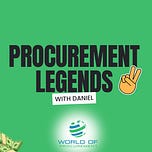AI-First Procurement: The iPhone Moment – Revolutionising Efficiency & Speed
Episode Summary: Join us for a deep dive into "AI-First Procurement: The iPhone Moment," a revolutionary shift that's fundamentally rewriting what's possible with human potential in the procurement world. This isn't just about making processes faster; it's about AI agents transforming entire industries, much like smartphones did. We'll explore how embracing an AI-first mindset, combined with flatter organisational structures, is delivering unparalleled speed, cost-efficiency, and strategic advantages, making traditional procurement approaches increasingly obsolete.
Key Discussion Points:
The "iPhone Moment" in Procurement:
This isn't an incremental improvement, but a fundamental transformation where AI agents are replacing industries and redefining human potential.
If you're still viewing AI as an "add-on," you're missing the revolution. The future belongs to those who understand that one strategically augmented human can outperform entire traditional teams.
Busting the Cost Myth: Embedded AI is the Future:
Forget the narrative that AI will break your budget; this is "dangerously misleading".
Embedded AI capabilities are becoming standard features in SaaS, not premium add-ons, with costs plummeting from $50K to $30K by 2027, a stark contrast to standalone AI tools projected to rise from $150K to $330K.
The "smart money is on platforms that embed intelligence as a core feature".
The David vs. Goliath Reality: Transformational Efficiency Metrics:
This isn't theory, but a "measurable reality". A single AI-first procurement professional managing eight specialised AI agents can achieve 60% of a traditional 10-person team's annual spend management ($35M vs $58M).
Dramatic Speed Increases:
A single AI-first professional is "9x faster in decision-making (2 days vs 18 days)".
Agentic teams maintain "2 to 5 day decision cycles compared to 8 to 18 days for traditional teams".
The comprehensive radar analysis rates agentic teams significantly higher on "decision speed (9 vs 4)".
Superior Cost-Effectiveness:
They are "51% more cost-effective ($28K vs $57K per million managed)".
Agentic teams deliver "40 to 50% lower cost per million dollars managed".
The radar analysis confirms superior "cost efficiency (8.5 vs 5.5)".
Massive Performance Multipliers (Throughput):
Single AI-first professionals achieve "5.6x more contracts processed monthly, 8.4x more suppliers evaluated, 9.0x more compliance checks completed, 7.3x more risk assessments conducted, and 7.5x more strategic projects delivered quarterly".
They manage "3.5x higher annual spend capacity on average".
These "performance multipliers remain consistent" (around 3.4x to 3.6x) even as teams scale from 1 to 10 people, because the "fundamental efficiency comes from the human-AI collaboration model".
Enhanced Compliance & Risk Reduction:
Agentic teams achieve "compliance scores of 95 to 98% versus 75 to 84% for traditional approaches".
They outperform in "compliance scores (9.6 vs 7.9)" and "risk reduction (8.8 vs 4.9)". AI agents can monitor hundreds of suppliers and process thousands of checks without fatigue.
Shift to Strategic Focus:
Critically, the AI-first professional is freed from "hierarchical approvals, manual compliance checks, and coordination overhead" to "focus on strategic decisions, relationship building, and value creation".
This leads to a much higher "strategic focus (8.7 vs 3.2)" for agentic teams.
The Flat Structure Advantage: Speed:
Traditional structures kill speed with "multiple layers of approval, handoffs, and coordination overhead".
Agentic structures maintain flat hierarchies where each human directly manages specialised AI agents, eliminating these bottlenecks and enabling dramatically faster decision cycles and greater agility.
The Mid-Market Sweet Spot:
For mid-market organisations, evidence "strongly supports a strategic shift toward lean, AI-first procurement structures".
Instead of traditional 5-10 person teams, 1 to 3 AI-augmented professionals can achieve superior outcomes at a lower cost.
"Smaller, AI-augmented teams consistently outperform larger traditional ones".
Your Next Steps: Becoming AI-First:
This transformation "isn't coming, but it's here." The question is whether you'll lead it or be left behind.
Start small but start now: Experiment with AI tools in your current role.
Develop crucial technical skills without becoming a programmer: "Prompt engineering is becoming as important as contract negotiation skills". Understanding how to brief and manage AI agents is vital.
Focus on strategic thinking as routine tasks become automated.
Build cross-functional relationships that will be crucial in flatter organisations.
Stay curious about emerging technologies and their procurement applications.
Consider learning platforms like Replit to understand the "technical foundations".
The Competitive Reality:
Organisations adopting agentic structures now will gain a compelling value proposition and establish "competitive advantages that become increasingly difficult for traditional approaches to match".
The "future belongs to lean AI-fast teams that will crush traditional structures in capability".
Call to Action: What's your experience with AI in procurement? Are you seeing the performance multipliers we've discussed? Share your thoughts in the comments below, and don't forget to subscribe to the AI Procurement Blueprint for more insights on becoming AI-first in procurement!












Share this post